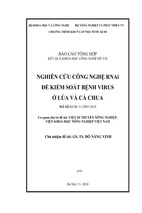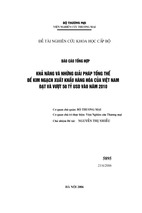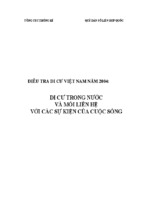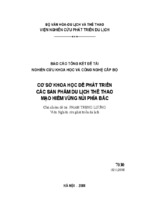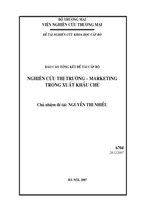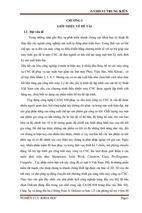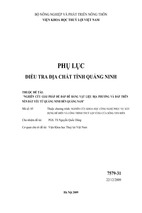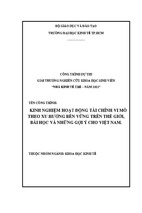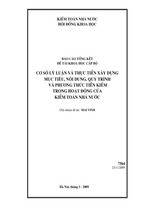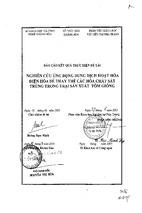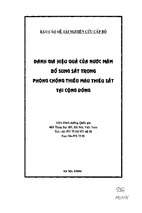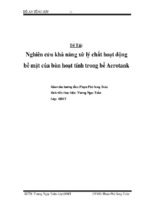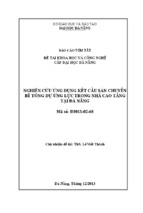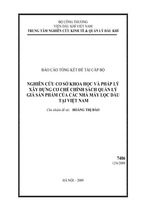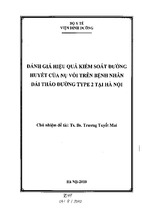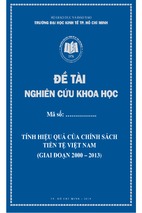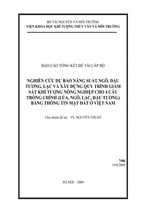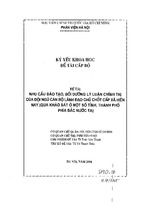CEPR
CEPR Working Paper
WP-01/2008
CENTRE FOR ECONOMIC AND POLICY RESEARCH
Economywide Effects of International Remittances:
A Computable General Equilibrium Assessment for Vietnam
Nguyen Duc Thanh
Centre for Economic and Policy Research
College of Economics, Vietnam National University, Ha Noi
CENTRE FOR ECONOMIC AND POLICY RESEARCH
COLLEGE OF ECONOMICS, VIETNAM NATIONAL UNIVERSITY HANOI
© 2008 Centre for Economic and Policy Research
College of Economics, Vietnam National University Hanoi
WP-01/2008
CEPR Working Paper
Economywide Effects of International Remittances:
A Computable General Equilibrium Assessment for Vietnam
Nguyen Duc Thanh1
E-mail:
[email protected]
Abstract
This research investigates economywide effects of international remittances on the source
countries, where Vietnam is taken as a case study. By using computable general
equilibrium (CGE) modeling techniques, we investigate, for the first time, the effects of
international remittances on the Vietnamese economy as a whole. Findings from the paper
strengthen the view that effects of remittances on developing countries are mixed and
complicated. The results show that in the context of Vietnam, where the growing
remittance inflows are combined with the economy’s increasing integration into the
international markets, all factor prices tend to rise, and industrial sectors are strongly
influenced and tend to contract. This implies that the long-run effects of remittances may
be negative on the supply side, and may offset their short-run positive effects on the
demand side.
Keywords: remittances, computable general equilibrium, macroeconomics, financial
flows, Vietnam
JEL Classification Numbers: F22, F24, F31, F40, D58
This working paper should not be reported as representing the views of the CEPR. The
views expressed in this working paper are those of the author(s) and do not necessarily
represent those of the CEPR.
1
Paper prepared for the 11th International Convention of the East Asian Economic Association on 15-16
November 2008, Manila, Philippines. I would like to thank Prof. Kenichi Ohno (GRIPS, Tokyo), Assoc.
Prof. Futoshi Yamauchi (IPFRI), Assoc. Prof. Nobuhiro Hosoe, Prof. Yoichi Okita and Prof. Tatsuo Oyama
(GRIPS) for their comments and suggestions. I am grateful to Mr. Bui Trinh (Vietnam General Statistics
Office) for providing me with the valuable data on the Vietnamese SAM. My special thanks to Dr. Bob
Baulch (IDS, University of Sussex) for carefully reading through my writing and providing me with helpful
comments. All remaining errors are mine.
2
Contents
Introduction...................................................................................................................... 4
An Overview of International Remittances to Vietnam ..................................................... 4
The Macroeconomics of Remittances ............................................................................... 9
A CGE Model for Vietnam............................................................................................. 12
Simulation Results.......................................................................................................... 22
Concluding Remarks ...................................................................................................... 25
References...................................................................................................................... 26
Tables
1. Remittances and selected economic aggregates, Vietnam 1999-2005…………………..5
2. Sources of remittances by country (%)………………………………………………….6
3. Reception of remittances to Vietnam by region (%)…………………………………… 7
4. Use of remittances (%)…………………………………………………………………..8
5. Labels of sectors in the aggregated SAM (SAM7)…………………………………….20
6. Other labels in SAM7…………………………………………………………………..21
7. Percentage changes in selected macro variables……………………………………….23
8. Percentage changes by industry, Scenario 1…………………………………………...23
9. Percentage changes by industry, Scenario 2…………………………………………...24
Figures
1. Distribution of remittances by area……………………………………………………...7
2. Production technology…………………………………………………………………15
3. Flows of marketed commodities……………………………………………………….17
Appendices
1. 3-Sector SAM 2000 ……………………………………………………………………33
2. Behavioral Parameters for the Model ………………………………………………….17
3
Introduction
International remittance flows have become increasingly important to developing
countries. Consequently, numerous empirical studies on the effects of remittances have
been conducted. However, there is limited research using computable general equilibrium
(CGE) models to examine the economywide impact of remittances. A strong point of CGE
models is that they enable us to assess the impact on various aspects of the economy
simultaneously. For that reason, this chapter aims to contribute to the literature by
employing a CGE model to investigate effects of remittances on the Vietnamese economy.
The paper is organized as follows. The next section provides an overview of the current
situation of remittance flows into Vietnam and the literature related to the issue. Section 3
reviews the state of the debate on macroeconomic impacts of remittances. Section 4
presents a CGE model for Vietnam. The model is then used to explore effects of
remittances on the Vietnamese economy. Simulation results are analyzed in Section 5.
The last section concludes.
An Overview of International Remittances to Vietnam
Due to historical as well as economic reasons, there are currently more than three million
Vietnamese people (3.5% of its population) living abroad, of which 80 percent are
residing in developed industrial countries. These people have been annually remitting to
Vietnam a considerable amount of money. In this study, the money sent back by
Vietnamese people who have been residing abroad for more than one year is considered as
remittances. In 2000, the total value of remittances was reported to reach USD 1.757
billion. The value doubled in 2005 and nearly equaled 7% of the country’s GDP. Table 1
presents data in remittances and other economic indicators of Vietnam during 1999-2005.
It is evident that the amount of remittances has been growing steadily over recent years.
While the total value of remittance flows before 1999 was still smaller than that of FDI
and ODA, in 2002 it surpassed both of them, and in recent years the gaps between them
have even become increasingly larger.
4
Year
Remittances*(a)
Net private transfer
GDP
Exports
Trade balance
FDI (b)
ODA(c)
REER(d)
1999
2000
2001
2002
2003
2004
2005
1,200 1,757 1,754 2,067 2,631 3,000** 3,500**
1,050 1,340 1,100 1,767 2,100
2,310
3,150
28,300 29,626 31,938 34,865 39,300 45,447 52,800
11,540 14,449 15,027 16,706 20,149 26,458 32,442
1,080
378
627 -1,054 -2,582
-2,287
-838
2,253 2,181
--- 2,023 1,894
1,878
1,972
970 1,361
958 1,073 1,258
1,394
1,432
103.0 100.0 100.1
98.3
90.6
89.3
93.2
Table 1. Remittances and selected economic aggregates,
Vietnam 1999-2005 (current price, USD million)
*: transferred through the Vietnamese banking system, estimated by the State Bank of Vietnam (SBV)
**: roughly estimated from current daily newspapers by the author
(a)
: from Hernández-Coss (2005)
(b)
: pre-2001 is proxied by total FDI disbursement (Table 29, IMF 2003), 2002 onward by gross FDI
inflows in the balance of payment (Table 3, IMF 2006).
(c)
: pre-2002 is from IMF (2003), Table 24, 2002 onward is from IMF (2006), Table 3.
(d)
: period average, from IMF (2006) except 1999 from IMF (2003).
Source: Hernández-Coss (2005), IMF (2003, 2006)
By its visible significance remittances have become an issue drawing the public and
authorities’ attention. As a result, more researchers have become interested in the theme
(Dang Nguyen Anh 2005, Hernández-Coss 2005, Nguyen Thi Thuy Linh 2006, Pfau and
Long (2006)).
Dang Nguyen Anh (2005) discusses the importance of the Vietnamese diasporas overseas
as active sources of remittances and investment, as well as human capital and technology.
He finds that, besides the attraction from an economy increasingly progressing and being
liberalized, government policies that have facilitated the transfer and use of remittances
have brought about a surge in the remittance flows into the country.
In examining the Canada-Vietnam remittance corridor, Hernández-Coss (2005) presents a
good resource for understanding not only how money is remitted from Canada, but also, to
some extent, the Vietnamese remittance transfer system in general. According to the
author, the informal funds transfer system is playing an important role, and, thanks to its
“perceived reliability, reasonable fees, speed and cultural familiarity,” can effectively
compete against the formal system which is still in early development. Hernández-Coss’s
research also provides a useful up-to-date review of the Vietnamese regulations over
remittances.
5
However, despite the magnitude of remittances, there are a few quantitative studies that
allow us to fully understand the sources and destinations of remittances, and, more
importantly, how they are used and how they affect the economy.
Pfau and Long (2006) approach these questions by examining the results in different
Vietnam Living Standard Surveys (VLSS 1992/93, 1997/98, 2002, and 2004). They find
that most of the remittances are from the United States and other industrial countries.
During the 1990s, there was a strong reduction of remittances from the Eastern Europe,
where many Vietnamese used to work. Remittances from the United States had increased
significantly, from around 40% of the total in the early 1990s to almost 60% near the end
of the decade (Table 2).
1992/93
By country
Laos
Cambodia
Thailand
China
Hong Kong
Taiwan
Australia
France
Western Europe
Former Soviet Union
Eastern Europe
United States
Canada
Others
By region
North America
Europe
Australia
Asia
Others
1997/98
0.0
0.2
0.3
0.2
0.0
n/a
7.3
2.8
9.9
3.4
9.3
41.1
6.2
19.2
0.0
0.0
0.4
0.2
1.1
0.8
8.6
4.0
7.7
3.2
3.9
57.7
6.1
6.5
47.3
20.0
7.3
4.2
19.2
63.8
15.6
8.6
5.6
6.5
Table 2. Sources of remittances by country (%)
Source: Pfau and Long (2006)
Table 3 shows the distribution of remittances throughout the country. Geographically, the
Red River delta (the location of the national capital, Hanoi) and the South East (with
Hochiminh City as its center) are the two major regions leading in all criteria: population,
remittances received, and the density of people receiving remittances. In the early 1990s,
these two regions, which accounted for 38 percent of the population, received almost three
quarters of total remittances to the country. However, there has been an obvious shift in
6
the distribution of remittances, with declines in share of the two poles and improvements
in all other regions, notably the North Central Coast and Mekong River Delta. This shift
may reflect the fact that during the last decade, the sources for migrant workers had moved
away from the two big urban regions to neighboring regions.
share of total pop
share of total
remittances
ratio of remittances
received to pop
share of total pop
share of total
remittances
ratio of remittances
received to pop
share of total pop
share of total
remittances
ratio of remittances
received to pop
2004
ratio of remittances
received to pop
2002
share of total
remittances
1997/98
share of total pop
1992/93
Region
Red River delta
North East
North West
North Central Coast
South Central Coast
Central Highlands
South East
Mekong River Delta
20.9
14.2
2.6
12.8
9.5
2.3
15.9
22.5
30.9
3.0
0.2
1.2
8.0
0.7
42.6
13.3
1.5
0.2
0.1
0.1
0.8
0.3
2.7
0.6
19.6
15.1
2.9
13.8
8.5
2.8
15.9
21.5
15.8
2.8
0.0
6.9
9.9
0.3
49.1
15.3
0.8
0.2
0.0
0.5
1.2
0.1
3.1
0.7
21.9
11.9
2.7
13.4
8.5
5.8
14.6
21.3
9.5
5.7
1.0
9.5
9.8
2.8
29.2
32.5
0.4
0.5
0.4
0.7
1.2
0.5
2.0
1.5
22.1
11.6
3.0
13.1
8.7
5.0
16.2
20.4
19.5
3.9
0.7
10.9
9.9
1.8
31.6
21.8
0.9
0.3
0.2
0.8
1.1
0.3
2.0
1.1
Urban/Rural
Rural
Urban
80.0
20.0
20.9
79.1
0.3
4.0
77.6
22.4
25.2
74.8
0.3
3.3
76.8
23.2
49.0
51.0
0.6
2.2
74.1
25.9
49.9
50.1
0.7
1.9
Table 3. Reception of remittances to Vietnam by region (%)
Source: Pfau and Long (2006)
There was also a shift between urban and rural areas in general. Figure 1 illustrates this
trend. While the share of rural population has tended to fall gradually (Table 3), its share
in total remittances tended to rise steadily. It is probably because at an early stage,
opportunities to go to work abroad might fall more to urban people who normally have
advantages in accessing information about employment abroad. But over time, on one
hand the supply of urban labor might decline, and on the other hand the information might
spread more extensively, leading to an increase in the number of migrant workers from
rural areas.
7
100%
90%
80%
70%
60%
Urban
50%
Rural
40%
30%
20%
10%
0%
1992/93
1887/98
year
2003
2004
Figure 1. Distribution of remittances by area
Source: Pfau and Long (2006)
An issue of high importance but also much ambiguity is the way in which remittances are
used. An accurate answer for this question may shed a light on the debate over the real
effects of remittances. Table 4 reports that 73 percent of remittances were allocated to
immediate consumption, while 14 percent were saved for “household construction” and
only around 6 percent for “investment.”
Consumption
Share of funds received
73.0
Household
construction
14.4
Non-farm
investment
6.0
Others(a)
6.6
Table 4. Use of remittances (%)
(a): including education and farm investment.
Source: Pfau and Long (2006)
For a more detailed understanding of household consumption, Nguyen Thi Thuy Linh
(2006) provides a number of findings. By examining the VLSS 2002, the author
investigates the effects of remittances (both international and internal) on expenditure
patterns of the Vietnamese households. She finds that households that receive
international remittances tend to spend a larger share in additional incomes for house
construction. The spending is most evident in the cases of poorest and richest household
groups. She then argues that while the former group spends on their needs, the latter tends
to spend as investments in real estate. From this point of view, it is rather difficult to
clearly distinguish household construction and investment as in Table 4.
8
By reviewing the previous works, one may come to note that, despite its rapid evolution
and widespread public awareness of the topic, the remittance issue in Vietnam has been
still inadequately studied and understood. This study, therefore, is an attempt to make a
contribution to the theme.
The Macroeconomics of Remittances
The growing body of theoretical and empirical studies on remittances has shaped the
economics of remittances. As Bouhga-Hagbe (2004) observes: “the literature on
remittances can be divided in two segments, one focusing on the causes and uses of
remittances, and the other on the macroeconomic impact of remittances.” In this section,
we mainly concentrate on the macroeconomics of remittances.
For the literature up to the end of the 1990s, Taylor (1999) provides a useful review. He
points out that current development in the field has moved toward the developmental
significance of remittances in and to developing countries, whose financial markets are
usually imperfect. Therefore, remittances play a role in helping to release credit
constraints. The changing vision in remittances’ role may shift the conventional view on
labor migration, constituting what he calls the “new economics of labor migration” (a term
originated from Stark and Bloom (1985)).
For a more detailed and updated overview of the field, Rapoport and Docquier (2005)’s
synthesized work is an excellent reference. On the macroeconomics of remittances, the
authors distinguish between short-run and long-run approaches. The short-run effects of
remittances can be most easily considered in a simple closed-economy Keynesian
framework, where an injection of remittances into the economy acts as an expenditure
shock in traditional models. However, in an open economy context, where a simple
Mundel-Flemming model with fixed prices and a single composite good may be applied,
the outcome turns out not so simple. It is shown that the overall effect of any demand
shock (including a shock induced by remittances) depends on the degree of capital
mobility and on the exchange-rate regime. In the case of perfect capital mobility and a
pure flexible exchange-rate regime, the equilibrium level of output is totally determined
by the money market and therefore is unaffected by international transfers.
Taking a longer perspective, the role of remittances in development has been a
controversial topic for decades. A key point is that whether the receiver uses remittances
9
for immediate consumption or for future production. Rapoport and Docquier (2005) show
that besides pessimistic views on the nonproductive use of remittances, there are reasons
to believe that international migration and remittances can help to untie a number of scarce
resource constraints such as financial credits, human capital, and entrepreneurship. That
remittances may reduce inequality and therefore contribute to economic growth and
development is also discussed.
As in other branches in economics, the macroeconomics of remittances is developed
through a rich body of literature interwoven with empirical and theoretical studies. Among
diversified views and attentions, one may roughly classify three groups of views. The first
group includes those who are optimistic on the role of remittances. For example, Adams
and Page (2003) find that both the scale of international migration (as measured by the
share of a country’s population that is living abroad) and international remittances
(defined as the share of remittances in GDP) have significant impact on reducing poverty
in the developing world. Ratha (2003) recognizes remittances as a large, stable (less procyclical) and growing source of finance. For these authors, remittances are expected to be
an effective financial source for development. The World Bank (2003, 2004, 2006)
generally shares this view. Giuliano and Ruiz-Arranz (2005) theorize that remittances can
promote economic growth by acting as a substitute for financial credits in domestic
markets. Their empirical work finds that the growth effect of remittances is most
significant in economies where financial markets are less developed. Bugamelli and
Paternò (2005) argue that the inflow of remittances can help to stabilize the current
account of emerging economies, and help to reduce the probability of sudden flight of
foreign capital. León-Ledesma and Piracha (2004) develop a model to study the positive
effect of remittances on the labor market (as remittances may be used for new investment
and then create new jobs), and investigate how remittances are used in a number of
Central and Eastern European countries. Their results show that “remittances are used for
investment and consumption in a similar way as other income, although biased more
toward investment.” (p. 77). Therefore, remittances have positive effects on labor markets
and the economy as a whole.
The second group, however, challenges the above optimistic views from almost every
direction. Lucas (2004) summarizes the core arguments of this group who argue that: “the
negative side [of remittances] is the potential for diminished labor supply and effort
10
induced by higher transfers, together with a Dutch disease-like effect in keeping the
exchange rate high and discouraging domestic production of tradeable goods” (p. 9).
Furthermore, Bracking (2003) argues that one of remittances’ harmful effects is that those
who do not receive remittances will find themselves relatively and even absolutely poorer
as the inflationary effect generated by those who receive remittances increases aggregate
consumption. In other words, households receiving remittances undermine the purchasing
power of those households without migrating members.
Chami, Fullenkamp and Jahjah (2005) contend that since remittance flows are not profitdriven (like FDI), their effect on growth may not be positive as commonly alleged. Their
argument is based on a microeconomic model that allows one to predict the behavior of
households receiving remittances. They use a panel of 113 countries during 19 years to
test their hypothesis. Their estimation results reveal evidence that remittances tend to be
negatively correlated with GDP growth. The authors argue that remittances do not seem to
serve as capital for economic development, but as compensation for poor economic
performance.
Even the conventional belief that remittance flows are usually countercyclical and can
therefore act as a “stabilizer” is challenged by the second group. By employing a panel
data set including 87 developing countries, for which information was generally available
from 1970 to 2000, Buch and Kuckulenz (2004) find that remittances share similarities
with the two other types of capital flows (FDI and ODA), but that remittance flows are
generally more stable. Additionally, Sayan (2006) shows that there is no clear-cut
evidence for this hypothesis. By investigating a group of 12 countries receiving
remittances, his empirical work shows that the results are mixed. Some countries seem to
begin to receive more remittances when a recession has happened, but some countries do
not. Remittance behavior seems again dependent on the individual characteristics of each
country.
Even if remittance flows are countercyclical, Chami et al. (2006) point out that their
effects are rather complicated. They use a stochastic dynamic general equilibrium model
to investigate the influence of countercyclical remittances on the conduct of fiscal and
monetary policy, and to trace their effects on real and nominal variables in a business
cycle setting. It is shown that remittances raise disposable income and consumption, and
insure against income shocks, thereby raising household welfare. However, remittances
11
increase the correlation between labor and output, thereby producing a more volatile
business cycle and increasing output and labor market risk. Therefore, it is suggested that
optimal monetary policy in the presence of remittances deviates from the Friedman rule,
and highlights the need for independent government policy instruments.
The third group of studies consists of those who argue the effects of remittances are
mixed. For example, Glytsos (2002a) discusses the diverse impacts of remittances on the
balance of payments, saving-investment balance and structural change of selected
Mediterranean countries. In a subsequent study, Glytsos (2002b) develops a Keynesian
model to investigate the macroeconomic effects of remittances. It is found that the effects
are mixed and dependent on countries’ characteristics. Kapur (2003) discusses the various
possible effects of remittances, both economically and politically. Concerning economic
effects, he notes the different possible effects, both negative and positive, at different
levels (household, community and national). Drinkwater et al. (2003) assess the impact of
remittances on labor market by combining two opposite effects: the first is the Dutch
disease-like effect (the hypothesis that remittances act as unemployment insurance that
causes the unemployment rate to rise), while the second is the allegedly positive role of
remittances (which release credit constraints and thus create more job opportunities). The
ultimate impact depends on which of these two effects that outweighs the other.
In summary, the role of remittances is still an interesting theme for debate. It is hard to
conclude whether remittances are purely beneficial or detrimental to the economy.
Therefore, empirical studies are of great importance for each concrete case. In the next
section, we will approach the issue by using a CGE model applied to the Vietnamese
economy.
A CGE Model for Vietnam
CGE Modeling and Its Applications
Computable general equilibrium modeling is one of today’s standard tools for economic
policy analysis (Arrow 2004). Developed by generations of economists, CGE modeling
techniques have been flourishing into numerous directions with diversified practical
applications. Brief reviews of this development can be seen, for example, in Chumacero
and Schmidt-Hebbel (2004) and Robinson (2003). Devarajan and Robinson (2005) discuss
extensive influences of CGE analysis in policy assessment.
12
While CGE models in the past were typically applied in developed economies whose long
tradition of data compilation is an advantage, today they have been extensively applied in
developing countries as well. Among a long list of studies, one may name some examples
such as Sapkota and Sharma (1998) for Nepal, Lloyd and Zhang (2001) for China, Mujeri
and Khondker (2002) for Bangladesh, and Thurlow and Seventer (2002) for South Africa.
CGE models cover a widespread and diversified range of issues, from their traditional
realm of assessing tax policy (such as Shoven and Whalley 1992) or trade policy (such as
Melo and Tarr, 1992), to other current issues such as the environment (Townsend and
Ratnayake 2000) and poverty reduction (Mujeri and Khondker 2002). In the field of
remittances, however, there are still few applications of CGE techniques.
Siddiqui and Kemal (2002) use a CGE model to estimate the effect of remittances on
poverty reduction in Pakistan’s economy within the context of trade liberalization.
Remittances to Pakistan have decreased during the research time span, and the authors
hypothesize that this reduction will have a negative impact on the poor in the country. The
research finds that tariff reduction in the absence of a decline in remittances reduces
poverty in both the rural and urban areas of Pakistan. It is shown that the gain in welfare is
larger for urban households than for rural households. In a second scenario, where trade
liberalization accompanies a decline in remittances, welfare in urban households decreases
but that of rural households still tends to increase. This implies that the combined shock is
more harmful to households in urban areas than for households in rural areas. However,
this welfare gain and reduction in poverty level in rural households is less than the welfare
gain and poverty reduction in the presence of trade liberalization only. The research
concludes that the decline in remittance inflows is a major determinant of the increase of
poverty in Pakistan.
Goce-Dakila and Dakila (2006) assess the impact of overseas Filipino workers’
remittances on the Philippines’s economy by using an inter-regional CGE model. Their
empirical results indicate that, in absolute terms, the main beneficiaries of rising
remittances are the middle-income classes across all regions. The second major
beneficiaries are the low income households, again for all regions, with the notable
exception of the National Capital Region, where high-income households are the second
highest beneficiary of remittances.
13
In an attempt to apply CGE techniques to studying remittance issue of Vietnam, in the
following sections we present a CGE model for the country, and then apply it to examine
the effects of remittances on the economy.
A CGE Model for Vietnam
The state of CGE modeling in Vietnam
Efforts to use CGE models to study Vietnamese economic issues began in the late 1990s.
Receiving supports from John Whalley, Nguyen Chan and his colleagues produced a
number of CGE models to investigate the effects of tax policy in Vietnam (Nguyen Chan
et al. 1997, 1998, 1999, 2000, 2001, 2002). Some other works were done in collaboration
with international economists, such as Ezaki and Son (1997) and ESCAP (1998).
Dufournaud et al. (2000) assess forest policy using a CGE approach. Recently, there are
more and more young Vietnamese economists becoming interested in applying CGE
models to their research (Pham Thi Lan Huong 2000, Nguyen Manh Toan 2006).
The model’s structure
Our CGE model consists of a set of simultaneous equations that are able to explain all of
the payments recorded in an associated Vietnamese social accounting matrix (SAM). The
Vietnamese SAM will be discussed in the next section.
As a benchmark model, we primarily follow a standard structure presented in Lofgren et
al. (2002)’s work, a project carried out by International Food Policy Research Institute
(IFPRI). The structure is chosen because it includes a number of features designed to
reflect the characteristics of developing countries. It also incorporates additional features
developed from IFPRI’s research experiences. These features, which are important to
developing economies, include household consumption of nonmarketed (or home)
commodities, explicit treatment of transaction costs for commodities that enter the market,
and a separation between production activities and commodities that permits any activity
to produce multiple commodities and any commodity to be produced by multiple activities
(Lofgren et al. 2002: vi).
To capture the behavior of different actors in the economy, the following sub-sections
describe the model’s components in major blocks: production and trade, institutions,
commodity markets, and macroeconomic balances. A full description may be found in
Lofgren et al. (2002).
14
Production: Each producer (represented by an activity) is assumed to be a profit
maximizer. A producer’s profit is defined as the difference between the revenue and the
cost of primary factors and intermediate inputs. Profits are maximized subject to a
production technology, the structure of which is shown in Figure 2. A final commodity
(on the top of the figure) is produced by combining value-added and aggregate
intermediate inputs. The combination is assumed to follow a constant elasticity of
substitution (CES) or Leontief function, dependent on the nature of each production
process. The blocks on the left of Figure 2 indicate that value-added is a CES function of
primary factors. The blocks on the right shows that aggregate intermediate input is a
Leontief function of disaggregated intermediate inputs.
Commodity output
Activity level
(CES/Leontief)
Value-added
(CES function)
Intermediate
(Leontief)
Composite
commodities
Primary
factor 1
Primary
factor 2
Domestic
commodities
Imported
commodities
Figure 2. Production technology
Source: Lofgren et al. (2002)
Each activity produces one or more commodities according to fixed yield coefficients, and
a commodity may be produced by more than one activity. The revenue of each activity is
identified by the level of the activity, yields, and commodity prices at the producer level.
15
Since the producers maximize their profit, they employ factors up to the point where the
marginal revenue product of each factor is equal to its wage (or factor price or rent).
Factor wages may vary across activities. The wage differentials are assumed to result from
exogenous causes.
Institutions: In the model, institutions consist of households, enterprises, the government,
and the rest of the world. Only the households are divided into rural and urban, all others
are aggregated as single units.
The households receive income from the factors of production. They also receive transfers
from other institutions. Remittances are reflected in the flow from the rest of the world to
households and their amounts are assumed to be exogenous in foreign currency unit. The
households use their income to pay direct taxes, consume, make transfers to other
institutions, and save. The shares of direct taxes and transfers in household income are
assumed to be constant. Household consumption includes both home and marketed
commodities. Home commodities are purchased at producer prices, while marketed
commodities are purchased at market prices. The total consumption is allocated across
different commodities according to a linear expenditure system (LES) demand function,
which is derived from the maximization of a Stone-Geary utility function. The remainder
of household income is for saving.
Enterprises receive profits and factor incomes, and may also receive transfers from other
institutions. Enterprise incomes are allocated to direct taxes, savings, and transfers to other
institutions. Enterprises do not consume. Apart from this, the payments to and from
enterprises are modeled in the same way as the payments to and from households.
The government collects taxes and receives transfers from other institutions. All taxes are
at fixed ad valorem rates. The government uses its income for two purposes: purchasing
commodities for consumption and making transfers to other institutions. Government
consumption is fixed in quantity whereas government transfers to domestic institutions
(households and enterprises) are fixed in real terms (CPI-indexed). Government savings is
the difference between government income and expenditure.
The final institution is the rest of the world. Transfer payments between the rest of the
world and domestic institutions and factors are all fixed in foreign currency unit. Foreign
16
savings (or the current account deficit) is the difference between foreign currency
spending and receipts of the economy.
Commodity Markets: As noted, there are two kinds of commodities: home-consumed
and marketed. Only home-consumed output does not enter markets. Figure 3 shows the
physical flows for marketed commodities along with the corresponding quantity and price
variables, which are identified in the model equations described in Appendix 1.
Commodity
output from
activity 1
(QXAC:PXAC)
CES
Aggregate
output
(QX:PX)
Aggregate export
(QE:PE)
CET
Commodity
output from
activity 2
(QXAC:PXAC)
Domestic sales
(QD:PDS-PDD)
Aggregate import
(QM:PM)
CES
Composite commodity
(QQ:PQ)
Household
consumption
(QH:PQ)
Government
consumption
(QG:PQ)
Investment
(QINV:PQ) +
(qdst:PQ)
Intermediate
use
(QINT:PQ)
Figure 3. Flows of marketed commodities
Source: Lofgren et al. (2002)
The first stage in the chain (upper left blocks) deals with the issue of how to generate a
commodity’s aggregated domestic output from the output of different activities, which are
imperfectly substitutable. A CES function is used as the aggregation function. The
demand for the output of each activity is derived from the optimization problem that
minimizes the cost of supplying a given quantity of aggregated output subject to this CES
function. Commodity prices serve to clear the market for each disaggregated commodity.
At the next stage, aggregated domestic output is allocated between exports and domestic
sales. It is assumed that suppliers maximize sales revenue for any given aggregate output
17
level, subject to imperfect transformability between exports and domestic sales, expressed
by a constant elasticity of transformation (CET) function. We use the small country
assumption that world demands for exported commodities are infinite and domestic
suppliers take world prices as given. If a commodity is not exported, all of its output is
directed to the domestic market.
Domestic demand is the sum of demands for household consumption, government
consumption, investment, intermediate inputs, and transactions (trade and transportation)
inputs.
Related to imported commodities, the model assumes that all domestic market demands
are represented by a composite commodity, which is made up of imports and domestic
output. Imported and domestic commodities are imperfect substitutable and captured by a
CES aggregation function. The demands for them are derived from the solution of
domestic demanders’ maximization problem that minimizes cost of obtaining a given
quantity of composite commodity subject to the CES function. Commodities that can not
be imported are supplied by domestic producers, whereas commodities that can not be
supplied by domestic producers are all imported. The demands for imported commodities
are met by international supplies that are infinitely elastic at given world prices. The
import prices paid by domestic customers include import tariffs and the cost of domestic
transaction services, which is a fixed proportion in each import unit. Similarly, the derived
demand for domestic output is met by domestic suppliers.
Flexible prices equilibrate demands and supplies of domestically marketed domestic
output.
Macroeconomic balances: The model includes three macroeconomic balances: the
(current) government balance, the external balance (the current account of the balance of
payments), and the savings-investment balance.
For the government balance, it is assumed that government savings is a flexible residual
while all tax rates are exogenous.
For the external balance, which is expressed in foreign currency, it is assumed that the real
exchange rate is flexible while foreign savings (the current account deficit) is fixed.
Concerning the savings-investment balance, the total value of private savings is assumed
to adjust to the investment. Real investment quantities are assumed to be fixed at an
18
exogenous level. To generate savings that equal the investment demand, the base-year
savings rates of selected nongovernment institutions are adjusted by the same number of
percentage points. It is also assumed that the private savings is automatically mobilized to
fully meet the demand for the investment which is fixed in real terms.
The Consumer Price Index (CPI) is fixed at 1 to act as the numéraire. This means, all
prices in the model are adjusted for CPI.
A full mathematic statement of the model is presented in Appendix 2.
Database compilation
For modern CGE models, social accounting matrices (SAM) play the crucial role of a
consistent and convenient database to be used for calculation. A SAM is a comprehensive,
economywide data framework, typically representing the economy of a country (Lofgren
et al. 2002). On the structure and use of a SAM, see Reinert and Roland-Host (1997) or
Cohen (2002) for more detailed discussions.
The present research employs the latest SAM of Vietnam. This SAM was constructed by
the Central Institute for Economic Management (CIEM) of Vietnam and the Nordic
Institute of Asian Studies and formally released in 2004. The SAM is based on the inputoutput (I/O) table for the year 2000 and other official statistics. Therefore, it is commonly
called the 2000 SAM in Vietnam. Those who are interested in the details of the SAM may
refer to its documentation by Jensen et. al (2004). In this section we only describe its
major characteristics related to the CGE model.
The fully disaggregated version of the 2000 Vietnam SAM is a matrix with dimensions
269x269. There are 112 production activities with 114 counterpart commodities. In
addition, there are 14 factors, 16 household groups, three enterprise types, one recurrent
state expenditure account and seven tax accounts, one investment/savings account and one
balance of payments account referring to foreign trade and capital flows.
Factors include twelve types of labor, one aggregate capital factor and one aggregate land
factor. Labor is disaggregated in three dimensions: rural-urban location, gender type and
skills (including unskilled, medium-skilled and skilled). Household disaggregation, which
is based on categorizing the household head, involves 16 household types, taking account
the rural-urban and male-female headed dimensions, which are each sub-divided into self-
19
employed farmers, self-employed non-farmers, wage-earners and non-employed.
Enterprises include state, private (non- state) and foreign-invested companies.
The original SAM is aggregated into several smaller standard SAMs, which are also
reported in Jensen et. al (2004). These SAMs are named following the number of
aggregated sectors. They include: SAM 31, SAM19 and SAM3 and MacroSAM (SAM1).
As an illustration, SAM3 is exhibited in Appendix 1.
For the purpose of this paper, SAM19 has been aggregated into a 7-sector SAM, which
we henceforth call SAM7. Our choice of sector aggregation is presented in Table 5. Labels
of sectors in SAM7 are also used as sector code in the model’s reports appearing in this
study.
Sector
Agriculture
Forestry
Fishery
Mining and quarrying
Manufacturing
Electricity, gas and water supply
Construction
Wholesale and retail trade; repair of transport vehicles,
personal and household goods
Hotel and restaurant
Transportation, storage and telecommunication
Financial intermediation
Science and technology
Real estate and consulting
Public administration and defense; compulsory social
security
Education and training
Health and social protection
Recreational, cultural and sport activities
Activity of the party and associations
Community, household and personal services
SAM19’s Sector
Labeling
01-AGR
02-FOR
03-FISH
04-MIN
05-MANU
06-EGW
07-CONS
SAM7’s Sector
Labeling
01-AGR1
08-TRADE
09-HOTEL
10-TRANS
11-BANK
12-SCIEN
13-REALCON
05-TRADE
06-SER1
01-AGR2
03-IND
04-CONS
07-SER2
14-ADMDEF
15-EDU
16-HEALTH
17-CULT
18-ASSO
19-OTHER
Table 5. Labels of sectors in the aggregated SAM (SAM7)
Other elements in SAM7 are the same as that of SAM19. Their names and labels are
reported in Table 6.
20



